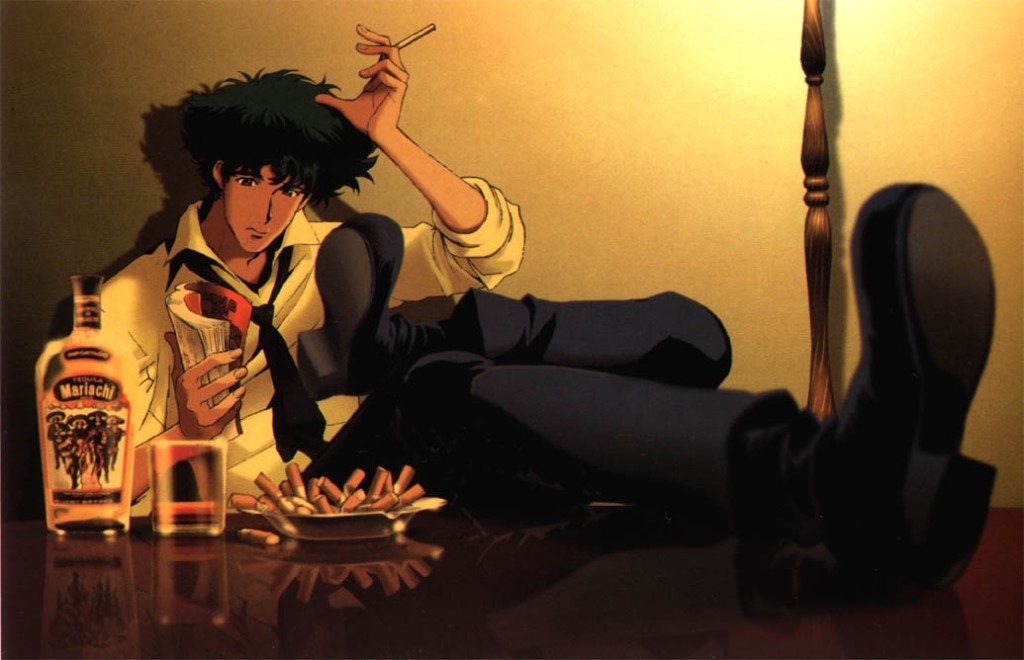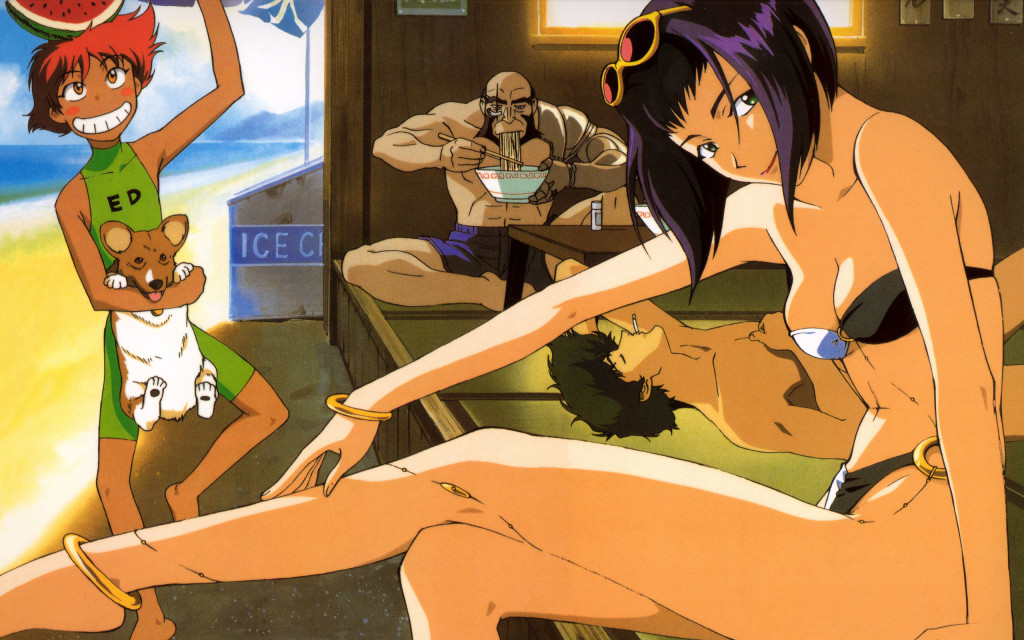Genre: Sci-fi
Premise: In the far-off future, inter-planetary bounty hunting becomes a hot profession. But when a mysterious bounty is put on one bounty hunter’s head, he must find out who did it, and kill them before he becomes a victim of his own profession.
About: Cowboy Bebop was a popular anime series in Japan in 1998, and then later in America – so much so that most people consider it the gateway series for Americans who want to get into anime. For awhile, Keanu Reeves was attached to this project, but I’m not sure if that’s the case anymore. Peter Craig adapted this draft of the property. You might recognize him as the writer of The Town. He’s been writing many big assignments since, including Top Gun 2, Bad Boys 3 and a remake of The Birds. He wrote this draft of Cowboy Bebop at around the same time he did The Town. This is a 2009 draft. It’s not known whether they’ve rewritten the script or brought on new writers since.
Writer: Peter Craig
Details: April 25, 2009 draft
I remember reading about this project back in the day when it became a hot commodity. These anime projects are tough sells in America though. On the one hand, they’re very cinematic, almost a perfect fit for the big screen. On the other, there’s a cultural disconnect in them that makes them hard to translate. The Japanese seem to be a little more liberal with their imagination (i.e. they dig stuff like planets that live and think) and with us Americans being more traditional in that capacity, we don’t always understand these eccentricities. And because some of these “eccentricities” are weaved so tightly into the plot, the American translations can feel goofy, even ridiculous. More on that in a bit.
Cowboy Bebop is the name of a bounty hunting spaceship. The captain of that ship is a rogue named Spike Spiegel. Naturally, he’s a handsome dude. Obviously, he’s got messy hair and a 3 day old beard. And of course he’s got a dark mysterious past. He’s joined by the gorgeous card shark Faye Valentine (also with a sketchy past) and Jet Black, a bionic-armed cook/ship owner (only a sort of dark past).
The Bebop (which, whenever you type, always comes out first as “Bepob”), is modeled after The Millennium Falcon. It’s beat up (or Bebop’d up). It’s always on its last leg. And nothing seems to work. Things are only getting worse for the poor ship with our crew running out of money. They need to land a big bounty to keep this hunk of steel puffing through the galaxy. You don’t want your ship to break down in the middle of the Intergalactic “In and Out” drive-thru line, do you?
Across the solar system, Spike’s onetime best friend (but now part of the evil Red Dragon Syndicate) Vicious, has just broken out of prison. And to show how bitter he is about his time there, he kills all his fellow inmates while leaving. Vicious wants to control all the oil in the solar system, since whoever controls the oil is king. All he has to do is kill the Red Dragon leader as well as his successor, who just so happens to be Spike!
So Vicious breaks into the Bounty Hunter Computer and puts a 400 million dollar price tag on Spike’s head! Spike, who so often has been the hunter, is now the hunted. He must not only convince his own crew not to turn him in (hey, 400 mil is a lot of money – of course they’re thinking about it) but escape the hundreds of bounty hunters who will now do anything to find him and bring him in – dead or alive.
Okay, so getting back to what I was saying earlier – the whole translation issue with these animes is messy. Because on the one hand, you have to give the core audience everything they know from the series or else they turn on you and start bad buzz. At the same time, you must eliminate the elements that just aren’t going to translate in America, which in some cases are major parts of the characters and story.
Take, for example, the fact that our hero, Spike, contains an eyeball that pulses (pulses??) and continuously plays all of Spike’s memories, so he’s simultaneously watching his past along with his present. There’s something cool in here SOMEWHERE, the idea that someone’s forced to watch their past on a loop. But it’s just too weird to play in a movie like this IF you want that movie to be taken seriously.
And that was another problem I had with Cowboy Bebop. I couldn’t figure out the tone. Were they trying to treat this the same way Christopher Nolan treated Batman? Where they made it as real as possible? At times I thought so. But then we’d all of a sudden land on a “Truck Stop” Asteroid Diner, like we were in a chapter from A Hitchhiker’s Guide To The Galaxy. So maybe this is more like The Fifth Element? It was hard to tell on the page.
And I’m not blaming Craig here. I think any writer would have trouble figuring this out. It’s the toughest part of adapting material like this – finding the perfect tone that balances the outlandish with the realistic. It’s why there tends to be so many writers on these projects. There’s so much trial and error involved before you finally steer that wayward ship onto a straight path.
As for the story, I think it was okay. The irony behind our bounty hunter hero getting a monster bounty on his head was fun. I thought the conflict within the ship (every crew member was looking over their shoulder) led to a lot of great tension. And the world-building itself was admirable (if a little predictable at times). And just bounty hunting itself is fascinating. It’s hard not to be drawn in by that subject matter.
However, there are parts missing from this vehicle. I hate to be the broken record but I believe the key to good sci-fi is an easy-to-follow plot. There’s usually so much world-building and so much backstory and so much exposition you have to give the reader, it’s hard to build a complicated story ON TOP OF THAT. And while I wouldn’t say Cowboy Bebop’s story was “overly-complicated,” it was just complicated enough that my mind began to wander. The only thing I truly understood was the bounty on Spike’s head. The rest of the stuff (Vicious’s secret plan to take over the solar system and where Spike was going to solve his bounty issue) was too vague, and that’s probably because it got lost inside all those other things I mentioned above.
And then there were the characters. After I read this, I went to the Cowboy Bebop Wikipedia page and I read through everything. I was surprised to see that each of these characters had a pretty elaborate and original backstory. And as I looked back at the script, I realized that much of that backstory was in there. So the million dollar questions was, why didn’t I feel that? Why did these characters seem generic and by-the-book to me? Why didn’t they “pop” the way their unique backstories would suggest they would? I’m not sure, but it’s been driving me crazy. I like to know why I don’t like a character.
Like yesterday. I didn’t like Llewyn Davis because he was the world’s biggest asshole and he was selfish and made a habit of fucking girls and making them get abortions. Wasn’t hard to figure out why I disliked him. With the crew of the Bebop, it’s still a mystery. Maybe it’s because I’ve seen Jet’s robotic arm thing a million times before (dating all the way back to the Mortal Kombat video games). Maybe because outside of his pulsing rewind-eye (which I didn’t like anyway), Spike was your garden variety rogue bounty hunter, a less charming less-cool version of Han Solo. And as you know, if the reader’s not on board with the characters, it really doesn’t matter what you write. They’ve already mentally checked out. And I checked out.
I’m not saying that this will be impossible to translate. It’s just going to take a lot of work, as well as a writer who knows exactly what to do. I hope they find that writer because there could be something here if they do.
[ ] what the hell did I just read?
[x] wasn’t for me
[ ] worth the read
[ ] impressive
[ ] genius
What I learned: “Trust Issues.” Characters who don’t trust each other but who have to work together is a dynamic that almost always works in a screenplay. Spike and Faye don’t trust each other further than they can throw each other here, but they’re on the same team and therefore have to work together. This is a natural recipe for conflict, which leads to one of the better dynamics in the script. You’d like to add a little something to every character relationship – something to give it life. “Trust Issues” is one of many options you can use.



